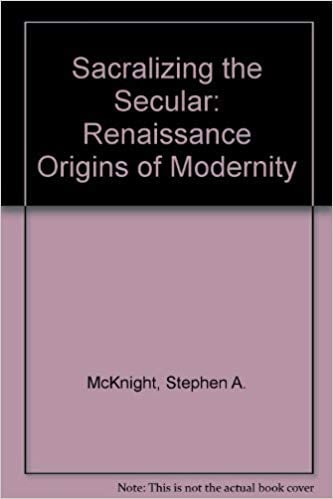It all depends on what we mean by “sacralizing” and “sacred,” and to a lesser extent by “secular.” The fact that Professor McKnight is a student of Eric Voegelin should not be left unmentioned in this regard, because for the recently deceased great scholar, “sacred” remained an elusive term. The word certainly referred to a dimension of man that differed from the secular and the profane, but it is not necessarily synonymous with what the monotheistic religions mean by it. To Voegelin, Eliade, Jung, Campbell, Rudolf Otto, and others, sacred meant the territory of awe, of numinous intervention, of participation in the cosmos and its forces.
In other words, for these scholars (and McKnight), the sacred is a tremendous worldview perfectly compatible with paganism, and to which Christianity has added a sui generis dimension but by no means annexed. We should keep these things in mind as we read McKnight’s book.
Through his analyses of important Renaissance figures, McKnight tries to show why the Renaissance is falsely credited with the intention of secularizing the Middle Ages, when in fact it had tried to resacralize the just opening secular world and worldview. Not surprisingly, questions arise immediately. First, what was secular in the course of the Renaissance? The Humanists (Petrarch, Erasmus) formed only a modest corner, enlarged only in retrospect by today’s modernists. Almost any Renaissance figure that scholars like Charies Nauert and Francis Yates studied was at least tainted by esoteric and occult interests and practices, whether Albrecht Diirer at one end or Francis Bacon at the other. Yates even brings Shakespeare in, and D.P. Walker of the Warburg Institute augments the list with many more names. In short, the line of demarcation between “secularizers” and “sacralizers” is becoming blurred.
But let us grant that the Renaissance was by and large a secular movement. In what sense did the men studied by McKnight sacralize it? True, they referred to an enormous ancient tradition of a basic wisdom, a prisca theologia, of a religion whose teachers were supposed to have taught Plato as well as Moses; their documents were obviously later fabrications, but accepted in good faith; their content was Pythagorean geometry, the Jewish Cabala, the Gnostic systems, and much more. The main objective was to redefine man, from Christian to magus, ultimately a terrestrial god in whose hands knowledge and power are equated. This much McKnight readily acknowledges and illustrates with appropriate quotations and discussion.
My question is: where is the sacralizing process in all this? Would it not be easier to set up another thesis? It could be briefly formulated. All those whom the author mentions were either loyal to the Christian religion or harboring other beliefs. A Marsilio Ficino and a Dürer fall in the first category, most of the rest in the second. The latter’s objective was to demonstrate its incompatibility with the imminently dominant worldview ruled by science (and power). In order to pursue this design they had very little at their disposal, and certainly not the conceptual edifice by which they could have promoted it. Hence they resorted to an ancient, half-mythical occult practice inimical to conceptualization. But what counts is their intention, which (I repeat) was purely secular.
By the 17th century, they had arrived at their goal. Science was born carrying an overload of secularistic philosophy. Our history books are correct: the great initiators were Bacon and Descartes; both (especially the latter) made tabula rasa of the old Aristotelian/Scholastic concepts and formulated an entirely new conceptual reference system. Had Francisco Giorgi, the early 16th-century Venetian monk, possessed the algebraic language that Descartes elaborated a century later, we would celebrate him today instead of Father Mersenne’s friend. The conclusion is that McKnight’s “sacralizers” did not intend to sacralize the secular. They were groping for a science, a secular one (if words have a meaning), for which they had neither a terminology nor instruments; and with Descartes and Galileo, or rather their successors, they entered into the possession of both.
McKnight renders himself even more vulnerable when he brings Comte and Marx into the debate as more modern sacralizers of the secular. It may be argued that a process of sacralization or resacralization has been going on, with Voegelin and McKnight as its chroniclers. But it is no mere pedantry, I think, to point out that the process can be subsumed under the category of secularization. Leszek Kolakowski pointed out in a 1973 essay that all the profane manifestations of things are accompanied by an intrinsic sacredness without which we could not even deal with them. The point is attractive, although it reduces the dimension of the sacred to a kind of cultural flavor, very popular these days. But it seems that neither Kolakowski nor McKnight speak actually of the sacred when they use the word. Not everything that is culture or cultural, or that expresses a human need to ritualize the secular and the profane, is sacred or sacralized. It would be better to understand the sacred as a divine intervention, not a manipulation of things in the name of half-understood mysteries.
McKnight’s unquestioned merit is to pursue the Voegelinian theme and to discover chapters of modernity where none was suspected. To do so, however, we ought to possess workable definitions of the sacred and the secular, and of modernity itself Much remains to be done.
[Sacralizing the Secular: The Renaissance Origins of Modernity, by Stephen A. McKnight (Baton Rouge: Louisiana State University Press) 131 pp., $25.00]

Leave a Reply